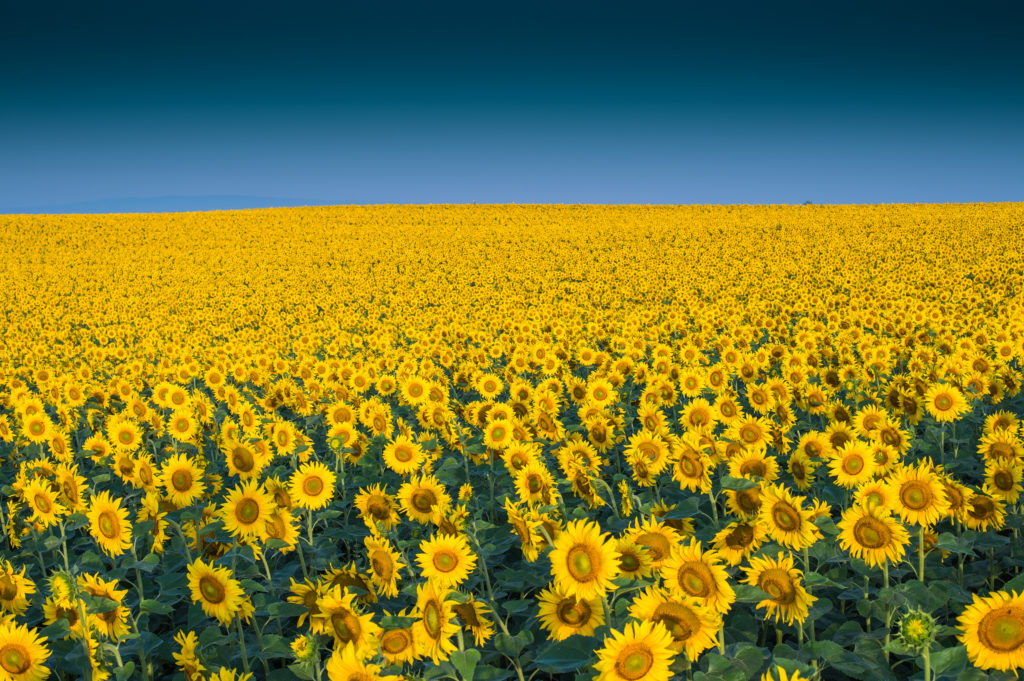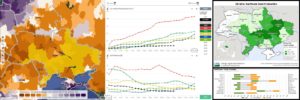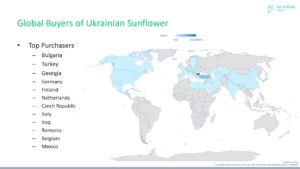
Global Crop Reports Identify Sunflower Production Progress and Identify Areas of Concern
Ukraine and Russia are the world’s top producers and exporters of sunflower seed and oil, together accounting for more than 50 percent of world production, according to the United Nations. The war in Ukraine will most likely disrupt not only the current season’s production but also the supply chain due to lack of access to sea ports. Besides disruption from the war, other key sunflower growing regions may also be disrupted due to overly dry conditions. Sunflowers are just one example of how today’s global food supply chain is more interconnected and interdependent than ever before. Volatility in one region creates ripple effects everywhere.
Sunflowers: A Minor Crop, a Major Symbol
Sunflowers, processed into cooking oil, meal and confectionary products, are a minor crop compared to soybean or even canola/rapeseed. In 2019, global sunflower oil production was 20 million tonnes. For sunflower seed, the global total was 50 million tonnes. While diminished exports from Ukraine in marketing year 2021/2022 may have less of a global impact than other crops, prices may still increase in the food production (cooking oil) and snack food industries due to reduced availability. Apart from their edible value, sunflowers have gained a different sort of value. They are the national flower of Ukraine, and the cheerful flower that moves with the sun has assumed a new global identity as a symbol of hope for a peaceful world.
Effect on Global Supply
Germany is an example of how Ukraine sunflower production can alter the dynamics of the global sunflower market. Germany does not have enough sunflower production to meet domestic demand. In 2020, Germany imported less than 2 percent of its sunflower supply from Russia and Ukraine. Although this reduces Germany’s concern about buying from these countries, the conflict could alter the dynamics of the global sunflower market.
It’s possible that decreased sunflower production could further burden an already distressed global cooking oil market. When it comes to cooking oils, sunflower can often be used as a substitute for canola and rapeseed — both of which are likely to experience production shortages due to the war in Ukraine. In the face of limited canola and rapeseed supplies, sunflower could easily appear to be a strong alternative, but with sunflower supplies likewise distressed, it may not be available to serve as a substitute, after all — potentially leaving cooking oil manufacturers without a solution and possibly leading to cooking oil shortages.
Given sunflowers’ comparatively small yield, the shakeup may be minimal. But as the market becomes more and more competitive, it’s increasingly important for companies, governments and NGOs at all spots along the agri-food supply chain to do whatever they can to minimize risk. EarthDaily Agro provides the data and insights to make those decisions more confidently.
Monitoring the Current Growing Season to Mitigate Food Security Concerns
To mitigate the effects of these uncertainties, EarthDaily Agro analyzes crop conditions worldwide. The data helps governments, NGOs and organizations across agriculture, food production and other industries monitor the current growing season and proactively decide how best to help mitigate food security concerns. If one growing region is unable to meet production and export expectations, can dependent importing countries grow enough to meet their own domestic requirements? If a country doesn’t grow its own sunflowers and its primary source is unavailable, where else can it get them? What climate conditions are affecting current growing conditions in other sunflower-growing countries such as Europe, China or North America? And, if there aren’t enough sunflowers to go around, what are the growing conditions of other crops that could make up for the deficit, such as rapeseed/canola and soy?
EarthDaily Agro helps answer these questions by harnessing the power of Earth Observation technology to actively monitor crop health around the world. EarthDaily’s regular crop-monitoring reports detect early warning signs of production distress long before on-ground surveys by analyzing soil moisture and cumulative precipitation as well as comparing current conditions to 30 years of Earth Observation data. Interpreting and analyzing the data, and converting it into useable insights, is a key service from EarthDaily Agro.
Access the Updated Sunflower Reports now
Current Conditions
The sunflower cycle is underway in the northern hemisphere, and sunflowers have been planted in most regions. Planting began in April and continued through May. Harvesting will begin in September and will continue through October. With planting complete, the attention is on weather conditions for growing. Drought in European regions and delay in planting in the U.S. are two primary points of concern that could impact yields.
Current conditions are as follows:
• Ukraine: Low soil moisture in June may affect crop development.
• Russia: Soil moisture varies across the crop-growing area — low in the south and west, but above average in the eastern sunflower zone.
• Europe: Drought in France and Spain is expected through June. Romania and Hungary also remain dry.
• China: Soil moisture is favorable for sunflower growing.
• Turkey: Soil moisture is increasing.
• United States: High rainfall delayed sunflower planting, but drier conditions are expected, which will aid progress.
Top Buyers who Need to Look Elsewhere
Sunflower supply is a concern in several countries that rely on Ukraine and Russia for some or all of their sunflower imports. Top buyers of Ukrainian sunflower seeds and oil include Bulgaria, Georgia, Germany, Turkey and Finland.
Georgia is at most risk, as it imports all of its sunflower from Ukraine and Turkey and does not have sunflower production to meet domestic demand. Bulgaria imports half of its domestic supply from Ukraine and Russia; crop conditions are currently favorable for their own domestic supply.
Crop-Monitoring Reports for Wheat, Corn and Rapeseed
EarthDaily crop monitoring reports focus on a different crop and its health across major producing countries as well as potential impacts to dependent importing countries. The initial report for wheat was released March 31, and a follow-up alert released May 11. Subsequent reports have also been released for corn (April 15), barley (May 5) and rapeseed (June 1). All these reports were updated in June, so you can have up-to-date information on the status of each of these crops.
About the Initiative
EarthDaily Analytics and its EarthDaily Agro agriculture division are harnessing the power of Earth Observation technology to actively monitor crop health around the world. Through this monitoring, EarthDaily is able to detect early warning signs of production distress, equipping food security organizations to take proactive action.
Learn more about the initiative at www.earthdailyagro.com/ukraine. For more information, contact our analysts, who can provide daily crop monitoring, weather forecasting and production estimation of crop-producing regions worldwide.



